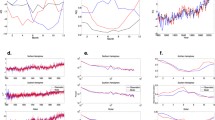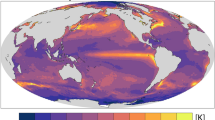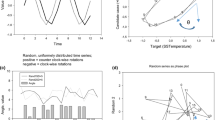Abstract
A stochastic climate model is used to explain the major features of seasonal phase-locking of climate variability in general. The model is the classical damped persistence model, generalized with seasonal cycles in the growth rate and noise forcing. Our theory predicts distinct phase-locking features for different seasonal forcing. With seasonal growth rate, the forced variance lags the growth rate within a season, with the initial persistence in phase with the variance. With seasonal noise forcing, the variance also lags the noise forcing within a season, but the initial persistence lags the variance by a season. The theory is further applied successfully to the phase-locking of SST variability over the tropical Pacific, North Pacific and the world ocean. Overall, the variance and persistence is forced predominantly by the seasonal growth rate in the tropics with the variance and persistence in phase, but they are forced by the seasonal noise forcing in the mid-latitude with the variance and persistence in quadrature or even out phase. Our theory provides a general framework and a null hypothesis for the understanding of phase locking of climate variability in general.









Similar content being viewed by others
Notes
Traditionally, in ENSO study, phase locking refers to the variance phase locking. Here, for clarity, we separate the phase locking of variance from the phase locking of persistence.
References
Alexander MA, Deser C, Timlin MS (1999) The reemergence of SST anomalies in the North Pacific Ocean. J Clim 12:2419–2433
Bennett W (1958) Statistics of regenerative digital transmission. Bell Labs Tech J 37:1501–1542
Cane MA, Zebiak SE (1985) A theory for El Niño and the Southern Oscillation. Science 228:1085–1087
Czaja A (2004) Why is north tropical Atlantic SST variability stronger in boreal spring? J Clim 17:3017–3025
Deelvira AR, Lemke P (1982) A langevin equation for stochastic climate models with periodic feedback and forcing variance. Tellus 34:313–320
Frankignoul C, Hasselmann K (1977) Stochastic climate models, Part II Application to sea-surface temperature anomalies and thermocline variability. Tellus 29:289–305
Ham Y-G, Kug J-S, Kim D, Kim Y-H, Kim D-H (2013) What controls phase-locking of ENSO to boreal winter in coupled GCMs? Clim Dyn 40:1551–1568
Hasselmann K (1976) Stochastic climate models Part I. Theory. Tellus 28:473–485
Huang JP, Cho HR, North GR (1996) Applications of the cyclic spectral analysis to the surface temperature fluctuations in a stochastic climate model and a GCM simulation. Atmos Ocean 34:627–646
Hurd HL (1974) Periodically correlated processes with discontinuous correlation functions. Theory Probab Appl 19:804–807
Jin FF, Kim ST, Bejarano L (2006) A coupled-stability index for ENSO. Geophys Res Lett 33(23):265–288
Jin Y, Rong X, Liu Z (2017) Potential predictability and forecast skill in ensemble climate forecast: a skill-persistence rule. Clim Dyn 51:2725. https://doi.org/10.1007/s00382-017-4040-z
Levine AFZ, McPhaden MJ (2015) The annual cycle in ENSO growth rate as a cause of the spring predictability barrier. Geophys Res Lett 42:5034–5041
Liu Z, Jin Y, Rong X (2019) A theory for the seasonal predictability barrier: threshold, timing, and intensity. J Clim 32:423–443. https://doi.org/10.1175/JCLI-D-18-0383.1
Mechoso CR, Coauthors (1995) The seasonal cycle over the tropical Pacific in coupled ocean–atmosphere general circulation models. Mon Weather Rev 123:2825–2838
Moon W, Wettlaufer JS (2017) A unified nonlinear stochastic time series analysis for climate science. Sci Rep 7:44228
Moore AM, Kleeman R (1996) The dynamics of error growth and predictability in a coupled model of ENSO. Q J R Meteorol Soc 122:1405–1446
Neelin JD (1991) The slow sea surface temperature mode and the fast-wave limit: analytic theory for tropical interannual oscillations and experiments in a hybrid coupled model. J Atmos Sci 48:584–606
Newman M, Compo GP, Alexander MA (2003) ENSO-forced variability of the Pacific decadal oscillation. J Clim 16:3853–3857
Ortiz MJ, Ruiz De Elvira A (1985) A cyclo-stationary model of sea surface temperatures in the Pacific Ocean. Tellus A 37A:14–23
Rasmusson EM, Carpenter TH (1982) Variations in tropical sea surface temperature and surface wind fields associated with the Southern Oscillation/El Niño. Mon Weather Rev 110:354–384
Rayner NA (2003) Global analyses of sea surface temperature, sea ice, and night marine air temperature since the late nineteenth century. J Geophys Res 108(D14):4407
Ren H-L, Jin F-F, Tian B, Scaife AA (2016) Distinct persistence barriers in two types of ENSO. Geophys Res Lett 43:10973–10979
Stein K, Schneider N, Timmermann A, Jin F-F (2010) Seasonal synchronization of ENSO events in a linear stochastic model. J Clim 23:5629–5643
Stuecker MF et al (2017) Revisiting ENSO/Indian ocean Dipole phase relationships. Geophys Res Lett 44:2481–2492
Thompson CJ, Battisti DS (2001) A linear stochastic dynamical model of ENSO. Part II: analysis. J Clim 14:445–466
Torrence C, Webster PJ (1998) The annual cycle of persistence in the El Nño/Southern Oscillation. Q J R Meteorol Soc 124:1985–2004
Tziperman E, Stone L, Cane MA, Jarosh H (1994) El Nino chaos: overlapping of resonances between the seasonal cycle and the Pacific ocean-atmosphere oscillator. Science 264:72–74
Tziperman E, Zebiak SE, Cane MA (1997) Mechanisms of seasonal–ENSO interaction. J Atmos Sci 54:61–71
Wakata Y, Sarachik E (1991) Unstable coupled atmosphere–ocean basin modes in the presence of a spatially varying basic state. J Atmos Sci 48:2060–2077
Webster PJ, Yang S (1992) Monsoon and ENSO: selectively interactive systems. Q J R Meteorol Soc 118:877–926
Xue Y, Cane M, Zebiak S, Blumenthal M (1994) On the prediction of ENSO: a study with a low-order Markov model. Tellus A 46:512–528
Yu J-Y (2005) Enhancement of ENSO’s persistence barrier by biennial variability in a coupled atmosphere-ocean general circulation model. Geophys Res Lett. https://doi.org/10.1029/2005GL023406
Yu J-Y, Kao H-Y (2007) Decadal changes of ENSO persistence barrier in SST and ocean heat content indices: 1958–2001. J Geophys Res Atmos 112:D13106
Zebiak SE, Cane MA (1987) A Model El Niñ–Southern Oscillation. Mon Weather Rev 115:2262–2278
Zhao X, Li J, Zhang W (2012) Summer persistence barrier of sea surface temperature anomalies in the central western north pacific. Adv Atmos Sci 29:1159–1173
Zheng F, Zhu J (2010) Coupled assimilation for an intermediated coupled ENSO prediction model. Ocean Dyn 60:1061–1073
Acknowledgements
This work is supported by Chinese MOST 2017YFA0603801, NSFC41630527 and US NSF AGS-1656907.
Author information
Authors and Affiliations
Corresponding authors
Additional information
Publisher’s Note
Springer Nature remains neutral with regard to jurisdictional claims in published maps and institutional affiliations.
Appendices
Appendix 1: Phase-locking in a recharge oscillator model
To study the phase-locking of oscillatory climate variability, such as ENSO, we use the recharge oscillator model (Jin et al. 2006; Stein et al. 2010; Levin and; McPhaden 2015):
where − b is proportional to the growth rate, N(t) is the Gaussian white noise forcing of unit variance, and \({\sigma _N}^{2}\) is the variance of the noise forcing. With all coefficients constant, the eigenvalues can be derived by inserting \(T\sim {e^{\lambda t}}~\) into the homogeneous equation of (A1) as
Therefore, the behaviors of the free modes have two frequency regimes. In the low frequency regime \(\Omega < b/2\), the free modes are two purely damped modes and therefore the forced system should still behave similar to an AR1 model. In the high frequency regime \(\Omega>b/2\), however, the free modes are damped oscillatory modes with a growthrate − b/2 and frequency \(\sqrt {{\Omega^2} - {{\left( {\frac{b}{2}} \right)}^2}}\). The stochastically forced response in (A1) can no longer be described as purely damped persistence model, or AR1 model. The nature of the free modes suggest that the seasonal phase-locking should be similar to our damped persistence model for very low frequency oscillation, but will be different for frequencies oscillations.
Seasonal phase-locking can be studied by imposing a seasonal cycle in the damping rate as in Eq. (2). With the annual frequency \(\omega\), we can expect three frequency regimes of phase-locking. First, in the low frequency regime \(\Omega<\hbox{min} \left( {b/2,\Omega} \right),\) phase-locking should be similar to an AR1 model, because (1) the free modes are all damped and (2) the long oscillation time scale will not be felt substantially during an annual cycle. Second, in the high frequency regime \(\Omega>\hbox{max} \left( {b/2,\Omega} \right)\), phase-locking should differ significantly from AR1 because the free modes exhibit oscillatory behavior and the oscillation is felt strongly within an annual cycle. Third, in the intermediate regime, \(\hbox{min} \left( {b/2,\Omega} \right)<\Omega <\hbox{max} \left( {b/2,\Omega} \right)\), a mixture of transitional behavior may occur.
The three regimes of phase-locking can be seen in Fig. 10, which shows 6 examples that are solved numerically from Eq. (14) and Eq. (2), with the parameters as \(b=0.1,~~\Omega=2 \pi /12,~~A=1.25.~\) As expected, for primary oscillation in the low frequency regime (\(2 \pi /\Omega=400{\text{~months}},\) and 200 months), phase-locking exhibits almost the same behavior as that in the AR1 model studied before, with the phases of the variance and lag-1 persistence almost in phase, peaking about 2.5 months after the maximum growth rate (Fig. 10a, b). When the primary frequency increases to the intermediate regime, \(\Omega<\Omega <b/2\), phase-locking exhibits a transition behavior from that almost of AR1 behavior at \(2 \pi /\Omega=40{\text{~months}}\) to a very different regime at \(2 \pi /\Omega=20{\text{~months}}\) where the peak variance and lag1-1 persistence are shifted earlier by 3 months and 5 months, respectively. The real world ENSO case therefore corresponds to the lower frequency case is similar to the case of \(2 \pi /\Omega=40{\text{~months}}\) and therefore can be reasonably represented in the AR1 model. When the frequency further increases to higher than annual \(\Omega>\omega\) (\(2 \pi /\Omega=10{\text{~months~and~}}5{\text{~months}})\), the phase-locking changes again: while the variance still lags the maximum growthrate by a season, the lag-1 persistence peaks earlier than growth rate and exhibits clear cycle of the primary frequency within a year.
Seasonal cycle of a variance and b lag-1 autocorrelation in a recharged oscillator model forced by a white noise modulated by the seasonal cycle of growth rate (brown dash). There are 6 cases with the delayed oscillation period ranging from 5 to 400 months, with each variance or correlation normalized by its maximum. The annual mean damping rate normalized by the annual cycle frequency is chosen as \({b_0}/\omega \approx 0.2\)
Appendix 2: Variance and persistence in the seasonal stochastic climate model
The general solution of SST variability in the stochastic climate model Eq. (2) as
with seasonal cycles in the growth rate and the noise forcing as in Eq. (3) and (4) (\(\beta\) means the phase difference between the growth rate and noise forcing), the lagged covariance function with forecast lead \(\tau>0\) can be derived as
where the nondimensional annualized damping rate is defined as
and the corresponding amplitude of the seasonal cycle of the growth rate is
The SST variance is therefore
For \({A_b} \ll 1\).
We have the leading order
where
For the case of noise forcing dominates, that is A = 0, and \(\beta =0\), then
The lagged correlation can be written as
For the terms of
Therefore,
For the case of growth rate dominates, that is D = 0, according to Eqs. 21 and 25, then
For the case of noise forcing dominates, that is A = 0 and \(\beta =0\), according to Eqs. 21 and 25, then
Rights and permissions
About this article
Cite this article
Jin, Y., Liu, Z. & Rong, X. General seasonal phase-locking of variance and persistence: application to tropical pacific, north pacific and global ocean. Clim Dyn 53, 2825–2842 (2019). https://doi.org/10.1007/s00382-019-04659-7
Received:
Accepted:
Published:
Issue Date:
DOI: https://doi.org/10.1007/s00382-019-04659-7





